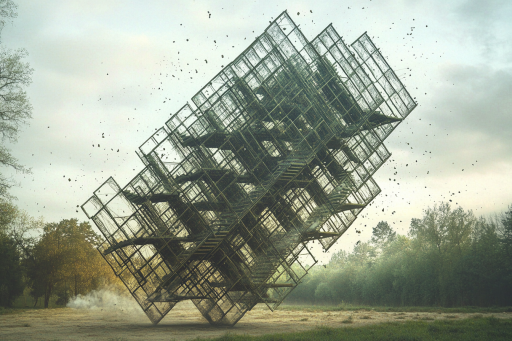
Scattered across the world are structures that challenge logic, appearing to bend, twist, or defy the very principles of geometry itself. Some seem to defy gravity, while others appear to exist in multiple dimensions at once. Engineers and historians alike struggle to explain their impossible forms, leaving behind more questions than answers. Are these architectural anomalies the result of lost knowledge, natural forces, or something even stranger?
The Impossible Staircase of Rajasthan

Deep in the heart of India, an ancient stepwell twists in ways that make no sense. The intricate network of staircases crisscrosses at odd angles, creating optical illusions where steps seem to lead both up and down at the same time. Those who walk its paths describe a dizzying, almost supernatural effect as their sense of direction collapses. Some believe its geometry was designed to confuse intruders, while others think it holds a hidden mathematical secret.
The Floating Monolith of Bolivia

At an ancient site in Bolivia, a massive stone slab appears to hover impossibly above the ground. The monolith is perfectly balanced on a seemingly inadequate base, defying expectations of weight and stability. Researchers have found no evidence of adhesives or modern engineering techniques that could explain how it remains upright. Some speculate lost technology, while others whisper about magnetic forces beyond our understanding.
The Tilted Towers of Antarctica

In the icy expanse of Antarctica, an enigmatic cluster of structures stands at an eerie, unnatural angle. Satellite images reveal geometric formations that appear too precise to be natural, yet no known civilization has ever lived in this region. Their slanted forms suggest an ancient design, buried for millennia under layers of ice. Scientists remain baffled, with theories ranging from lost human settlements to evidence of unknown geological forces.
The Shifting Pyramid of China

Hidden deep within the Chinese wilderness, an alleged pyramid appears to change shape when viewed from different angles. Some explorers claim to see a perfectly symmetrical structure, while others describe an irregular, distorted form that shifts unpredictably. No official surveys have been conducted, leading to speculation that the structure is either a natural illusion—or an architectural anomaly deliberately designed to deceive.
The Gravity-Defying Temple of Myanmar

Perched atop a sheer cliff, a golden temple balances on the edge of disaster—yet never falls. Despite its precarious position, the structure has withstood earthquakes and violent storms, seemingly immune to the forces of gravity. Devotees believe spiritual forces hold it in place, while scientists struggle to explain how such an unstable foundation has lasted for centuries. Whether by divine intervention or unknown physics, its defiance of nature remains unexplained.
The Twisting Ruins of Peru

High in the Andes, ancient ruins feature walls that appear to ripple and twist like waves. Unlike typical stone structures, these ruins do not follow straight lines, curving in ways that suggest a deep understanding of advanced geometry. Some researchers argue that the walls were designed to absorb seismic shocks, but no definitive explanation exists. The craftsmanship is so precise that even modern engineers struggle to replicate its impossible curves.
The Vanishing Arches of Scotland

A mysterious stone bridge in Scotland exhibits a bizarre optical illusion—arches that seem to disappear depending on the viewer’s perspective. Travelers report seeing multiple arches from one side, only to find them missing when they change angles. Scientists suggest an unusual alignment of shadows and angles, but local legends claim the structure was built by something not of this world.
The House That Shouldn’t Stand

In a remote European village, an ancient house seems to defy structural integrity. Its upper floors extend outward at impossible angles, unsupported by beams or columns. Engineers inspecting the site find no hidden reinforcements, yet the house has withstood centuries of storms and earthquakes. Is this a forgotten technique of medieval builders, or evidence of something physics has yet to explain?
The Labyrinth That Rearranges Itself

A crumbling ruin in the Middle East is rumored to shift its layout with every visit. Maps drawn by explorers rarely match, with doorways appearing where none existed before and corridors leading to different destinations. Some dismiss it as mere legend, while others believe an advanced civilization once manipulated space itself within its walls. Whether illusion or reality, the mystery of the shifting labyrinth endures.
Is Reality as Stable as We Think?

Some structures challenge not only our understanding of architecture but our perception of reality itself. If the natural laws of physics and geometry can be stretched in ways we don’t yet understand, what else might we be missing? Perhaps these strange sites are clues, reminders that the world is not as rigid and predictable as we assume. In the end, what if the real anomaly is not the structures, but our limited understanding of the universe?





